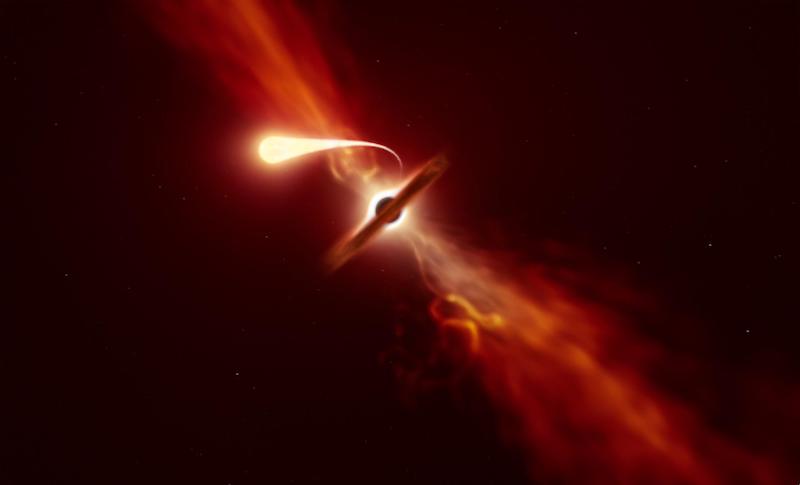
When astronomers saw an immensely bright flash of light in deep space earlier this year, they naturally wondered what caused it. Now, researchers at the Massachusetts Institute of Technology (MIT) and other institutions from around the world say they’ve solved the mystery. The flash – brighter than 1,000 trillion suns – originated from a jet of material shooting out from a supermassive black hole. They say the black hole was likely devouring a star. The flash of light was so bright because the jet was aimed toward the Earth.
Of course, there was no danger. The black hole, and its jet, are far beyond our Milky Way galaxy, in the depths of space, some 8.5 billion light-years from Earth.
The researchers published the news of their discovery in a new peer-reviewed paper in Nature Astronomy on November 30, 2022. A free preprint version of the paper is also available on arXiv.
A mysterious flash
Astronomers from NASA, Caltech and elsewhere used the Zwicky Transient Facility, an all-sky survey based at the Palomar Observatory in California, to detect the flash. Using multiple telescopes, the astronomers observed the flash in X-ray, ultraviolet, optical and radio wavelength bands. The astronomers named the flash AT 2022cmc.
Astronomers have seen black holes consume stars before. Cataclysmic events like these are called tidal disruption events (TDEs). The tidal forces of a black hole are so strong they can tear a star apart if it gets too close.
AT 2022cmc appeared to be rather unique, however. It was the brightest TDE ever recorded so far, and also the most distant, at 8.5 billion light-years.
Black hole jet pointed right toward Earth
But why was this tidal disruption event so bright? The astronomers say that when the black hole began to devour the star, it emitted a huge relativistic jet of material. That in itself isn’t unusual. In this case, however, the jet happened to be pointing right toward Earth. This could make the tidal disruption event appear brighter than it usually would otherwise. Scientists call this Doppler boosting, or relativistic beaming. And just to note, there’s no danger, since the black hole is more than halfway across the universe. Still, the amount of energy the jet released was enormous.
Other astronomers at the University of Birmingham used the European Southern Observatory’s Very Large Telescope in Chile to observe AT 2022cmc. They realized that the host galaxy was was much farther away than first thought. As Matt Nicholl at the University of Birmingham said:
Our spectrum told us that the source was hot: around 30,000 degrees, which is typical for a TDE. But we also saw some absorption of light by the galaxy where this event occurred. These absorption lines were highly shifted towards redder wavelengths, telling us that this galaxy was much further away than we expected!
Astronomers have previously found three other Doppler-boosted tidal disruption events so far, as well. AT 2022cmc is also the first one detected during an optical sky survey.
The feeding process
The researchers observed the light signal using the Neutron Star Interior Composition Explorer (NICER) telescope on the International Space Station. This telescope looks at the universe in X-rays, not visible light. At first, the astronomers thought the light flash might be a gamma-ray burst. However, as lead author Dheeraj “DJ” Pasham at MIT said:
Things looked pretty normal the first three days. Then we looked at it with an X-ray telescope, and what we found was, the source was too bright. This particular event was 100 times more powerful than the most powerful gamma-ray burst afterglow. It was something extraordinary.
The discovery sheds new light (literally!) on these tidal disruption events and how supermassive black holes form. Co-author Matteo Lucchini, a postdoc in MIT’s Kavli Institute for Astrophysics and Space Research, said:
We know there is one supermassive black hole per galaxy, and they formed very quickly in the universe’s first million years. That tells us they feed very fast, though we don’t know how that feeding process works. So, sources like a TDE can actually be a really good probe for how that process happens.
AT 2022cmc was very bright in the X-ray wavelength. In addition, though, the astronomers also observed that it varied by as much as a factor of 500 over a period of a few weeks.

A whirlpool of debris around the black hole
What caused this incredible amount of X-ray energy? The researchers say it was an “extreme accretion episode.” Basically, during a tidal disruption event, a star creates a whirlpool of material as the black hole is shredding it. That disk generates a massive amount of energy.
In the case of AT 2022cmc, as often happens, there was also the jet of material shooting out from the black hole. The astronomers wanted to know how fast the jet was moving, to generate so much energy and cause the bright flash. The answer, it turned out, was about as fast as anything can go. Luccini said:
We found that the jet speed is 99.99 percent the speed of light.
Wow! That is fast, indeed.
The black hole is probably in a hyper-feeding state, as Pasham noted:
A lot of this tidal disruption happens early on, and we were able to catch this event right at the beginning, within one week of the black hole starting to feed on the star.
The astronomers look forward to finding more such tidal disruption events. Lucchini said:
We expect many more of these TDEs in the future. Then we might be able to say, finally, how exactly black holes launch these extremely powerful jets.
Bottom line: An international team of astronomers says it has detected the most powerful jet of material ever seen coming from a black hole, 8.5 billion light-years away. And it’s pointed right toward Earth.











